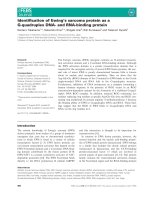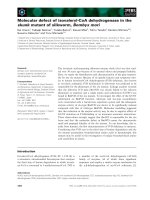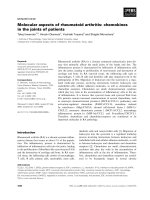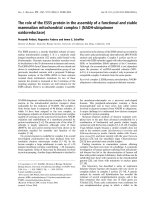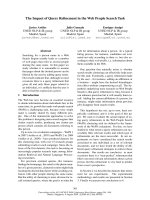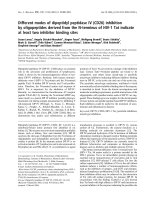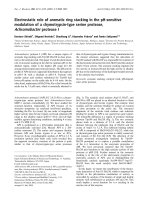Báo cáo khoa học: RNA reprogramming of a-mannosidase mRNA sequences in vitro by myxomycete group IC1 and IE ribozymes pptx
Bạn đang xem bản rút gọn của tài liệu. Xem và tải ngay bản đầy đủ của tài liệu tại đây (828 KB, 12 trang )
RNA reprogramming of a-mannosidase mRNA sequences
in vitro by myxomycete group IC1 and IE ribozymes
Tonje Fiskaa
1,
*, Eirik W. Lundblad
1,2,
*, Jørn R. Henriksen
1,3
, Steinar D. Johansen
1
and Christer Einvik
1,3
1 Department of Molecular Biotechnology, RNA Research group, Institute of Medical Biology, University of Tromsø, Norway
2 Department of Microbiology, University Hospital of North Norway, Tromsø, Norway
3 Department of Pediatrics, University Hospital of North Norway, Tromsø, Norway
Group I ribozymes, which normally perform intron
splicing reactions within the nucleus of many unicellu-
lar eukaryotes, can be modified to trans-splice 3¢
exons into separate RNA molecules in a sequence-
specific reaction. Group I intron trans-splicing is
initiated by the binding of an exogenous guanosine
(exoG) into the ribozyme guanosine-binding site. Sub-
sequently, base pairing between the internal guide
sequence (IGS) at the 5¢ end of the ribozyme and a
target RNA sequence creates a pseudo-P1 structure
containing the 5¢-splice site, which becomes attacked
by the bound exoG. The splicing reaction proceeds
through two consecutive transesterification steps.
When targeting mutated messenger RNAs, trans-spli-
cing may lead to chimerical reprogrammed transcripts
of biochemical or therapeutic interest. Despite the
fact that more than 2000 group I introns are known
by sequence [1], only a few have been applied in
RNA reprogramming approaches. The Tetrahymena
ribozyme has been used in almost all reported cases
of RNA reprogramming (including RNA repair) [2–
7], except for a few studies using the Pneumocystis
ribozyme [8,9] and the Didymium myxomycete ribo-
zyme DiGIR2 [10,11].
Keywords
a-mannosidase mRNA; group I intron; RNA
repair; RNA reprogramming; trans-splicing
Correspondence
S. D. Johansen, Department of Molecular
Biotechnology, RNA Research Group,
Institute of Medical Biology, University of
Tromsø, N-9037 Tromsø, Norway
Fax: +47 776 45350
Tel: +47 776 45367
E-mail:
*These authors contributed equally to this
study
(Received 17 March 2006, accepted 27 April
2006)
doi:10.1111/j.1742-4658.2006.05295.x
Trans-splicing group I ribozymes have been introduced in order to mediate
RNA reprogramming (including RNA repair) of therapeutically relevant
RNA transcripts. Efficient RNA reprogramming depends on the appropri-
ate efficiency of the reaction, and several attempts, including optimization
of target recognition and ribozyme catalysis, have been performed. In most
studies, the Tetrahymena group IC1 ribozyme has been applied. Here we
investigate the potential of group IC1 and group IE intron ribozymes,
derived from the myxomycetes Didymium and Fuligo, in addition to the
Tetrahymena ribozyme, for RNA reprogramming of a mutated a-mannosi-
dase mRNA sequence. Randomized internal guide sequences were intro-
duced for all four ribozymes and used to select accessible sites within
isolated mutant a-mannosidase mRNA from mammalian COS-7 cells. Two
accessible sites common to all the group I ribozymes were identified and fur-
ther investigated in RNA reprogramming by trans-splicing analyses. All the
myxomycete ribozymes performed the trans-splicing reaction with high
fidelity, resulting in the conversion of mutated a-mannosidase RNA into
wild-type sequence. RNA protection analysis revealed that the myxomycete
ribozymes perform trans-splicing at approximately similar efficiencies as the
Tetrahymena ribozyme. Interestingly, the relative efficiency among the
ribozymes tested correlates with structural features of the P4–P6-folding
domain, consistent with the fact that efficient folding is essential for group I
intron trans-splicing.
Abbreviations
exoG, exogenous guanosine; IGS, internal guide sequence; RPA, RNA protection analysis.
FEBS Journal 273 (2006) 2789–2800 ª 2006 The Authors Journal compilation ª 2006 FEBS 2789
RNA reprogramming in cell cultures based on the
Tetrahymena ribozyme remains inefficient in spite of
significant efforts to increase the specificity and effi-
ciency [6]. Several attempts to improve the reaction
have been performed, including extending the IGS at
the 5¢ end of the ribozyme to enhance target recogni-
tion [4,12,13], adding a P10 helix to promote the sec-
ond step of trans-splicing [12] and removing competing
side reactions to increase the accuracy [10]. We aim to
introduce new natural group I ribozymes in optimiza-
tion and application studies of the trans-splicing reac-
tion, and recently reported RNA reprogramming of a
mutated glycosylasparaginase mRNA sequence by a
Didymium myxomycete group IE ribozyme deficient in
hydrolysis [10]. Both the specificity and the efficiency
of trans-splicing were improved by extending the IGS
and by the removal of unwanted hydrolysis side reac-
tions by ribozyme modifications. Here we report the
mapping of accessible ribozyme target sites in a
mutant version of a-mannosidase mRNA isolated from
mammalian COS-7 cells. A strategy based on random-
ized IGS [3,11], using four distinct group I ribozymes,
the Didymium group IE ribozyme (named DiGIR2),
two Fuligo group IC1 ribozymes (named Fse.L569 and
Fse.L1898), and the prototype Tetrahymena group IC1
ribozyme (Tth.L1925), were used. Two accessible sites,
common to all four ribozymes, were identified and
included in site-directed RNA reprogramming.
Results and Discussion
Structural features of the myxomycete group IC1
and group IE ribozymes
The intron secondary-structure diagrams presented in
Fig. 1A show that all four ribozymes included in this
study have an overall similar structural organization of
the catalytic domain (P3–P7–P8). The different myx-
omycete ribozymes were selected as a result of their
pronounced in vitro splicing activities and because of
their distinct structural features [14,15]. Whereas
DiGIR2, derived from the twin-ribozyme intron
Dir.S956-1 in D. iridis [14,16–18] represents the group
IE ribozymes, the two F. septica ribozymes, Fse.L569
and Fse.L1898, represent group IC1 ribozymes [15].
Finally, the prototype T. thermophila group IC1 ribo-
zyme, Tth.L1925, was included as a reference control.
A dramatic variation in both sequential and struc-
tural features is noted among the folding domains pre-
sented in Fig. 1B (P4–P6). This domain varies in size
from only 94 nucleotides in DiGIR2 to 681 nucleotides
in Fse.L569, with the intermediate-sized Tth.L1925
and Fse.L1898 folding domains (157 nucleotides and
198 nucleotides, respectively) in between. The P4–P6
domain has an essential role in initiating the
RNA-folding process, leading to the functional 3D
architecture of a group I ribozyme [19–21], and the
high-resolution structure of the Tetrahymena ribozyme
domain [22,23] identified both intradomain (A–bul-
ge ⁄ P4 interaction, and L5b–P6 tetraloop receptor
interaction) and interdomain (P14 pseudoknot base-
pairing) tertiary interactions. DiGIR2 has a less
complex structure without any obvious intradomain
interactions and only one assigned (but apparently
weak) L9b–P5 interdomain interaction [14], features
typical of the IE subclass of nuclear group I ribo-
zymes. Fse.L569, on the other hand, harbours a group
IC1 folding domain with branched P5 (P5abc) and the
A-bulge in P5a. Large extensions are located in P5b
and P6, as well as in the highly unusual P5d region.
The latter region is more than 300 nucleotides long
and contains 17 identical copies of a 16-nucleotide tan-
dem repeat motif [15]. The repeat has probably no
important function in splicing as a mutant ribozyme
with only seven copies performs the self-splicing reac-
tion at similar rates, and cognate self-splicing intron
ribozymes in Badhamia and Diderma (Bgr.L569 and
Dni.L569, respectively) lack the repeat (S. D. Johansen
et al., unpublished results).
Group IC1 and group IE ribozymes select the
same accessible sites in an a-mannosidase mRNA
sequence
Deficiency of lysosomal activity of human a-mannosi-
dase, an exoglycosidase enzyme involved in the
ordered degradation of N-linked oligosaccharides,
results in the autosomal-recessive lysosomal storage
disorder, a-mannosidosis [24]. The most frequent
mutation in a-mannosidase is the R750W substitution,
and affected individuals accumulate partially degraded
oligosaccharides in the lysosome [25]. No causal treat-
ments are currently available for a-mannosidosis, and
there is thus a need for developing alternative gene
therapy approaches. Group I ribozyme-based mRNA
repair may represent an interesting new approach in
gene therapy by reprogramming RNA molecules carry-
ing disorder mutations. To investigate whether RNA
reprogramming could be applied on human a-mannos-
idase mRNA, total RNA isolated from COS-7 cells
expressing R750W mutant a-mannosidase was mixed
with ribozyme libraries designed to detect accessible
target sites within the messenger RNA. GN
4 ⁄ 5
ribo-
zyme-tag libraries (see Experimental procedures) were
constructed for each of the group I ribozymes
(Fig. 1A). During incubation at trans-splicing condi-
RNA reprogramming of a-mannosidase mRNA sequences T. Fiskaa et al.
2790 FEBS Journal 273 (2006) 2789–2800 ª 2006 The Authors Journal compilation ª 2006 FEBS
tions, a unique 3¢ exon tag (Fig. 1A) was trans-spliced
into various mRNA sequences, based on the accessibil-
ity to the ribozymes [11]. The resulting RNA recombi-
nants were detected and identified by an RT-PCR
approach, cloned into plasmid and subsequently DNA
sequenced. Here, a total number of 19 distinct clones,
all representing true trans-splicing events within an
1 kb region of the mRNA, were identified. This
region was chosen because it contains sequences
upstream of the R750W substitution (Fig. 1C) and is
thus suitable for RNA reprogramming by group I
ribozyme trans-splicing. Surprisingly, only three access-
ible sites were detected (Fig. 1C). Whereas the Tetra-
hymena ribozyme detected all three sites (U1357,
U1381, and U1732), the Fuligo and Didymium ribo-
zymes detected the same two sites (U1357, U1381).
Several interesting findings are noted from this experi-
ment, namely that (a) sites U1357 and U1381 appear
to be particularly accessible because they were detected
by all four ribozymes, (b) U1357, U1381 and U1732
could not be predicted as unambiguous accessible
regions by the mfold computer program (data not
shown), stressing the importance of determining
accessible sites within target RNAs experimentally,
(c) no obvious sequence similarities were seen between
the selected target sites and the natural 5¢ splice sites
of the ribozymes, indicating that the accessible site
detection was based on true selection, (d) two of the
selected target sites (U1357 and U1732) were identical
in sequence, but the latter was only detected by the
Tetrahymena ribozyme, and (e) the selected target
sequences GCACCU(1357 ⁄ 1732) and ACGACU1381
generate GC-rich P1 pairings, suggesting that increased
stability between ribozyme and target RNA is an addi-
tional selective factor [26]. In summary, we found that
group IC1 and group IE ribozyme-tag libraries are
able to select the same accessible sites within an endog-
enously expressed human a-mannosidase mRNA.
Increasing the trans-splicing specificity at
a-mannosidase RNA sites U1357 and U1381
The two accessible a-mannosidase RNA sites (U1357
and U1381) were selected for more detailed analysis in
RNA reprogramming because they were recognized by
all four ribozymes tested. In order to obtain more opti-
mal ribozyme targeting, several modifications in the ri-
bozyme structures were performed. These include IGSs
complementary to the sequences flanking U1357 and
U1381, as well as EGSs, 35 nucleotides in length,
complementary to the target RNA sequences 3¢ of
U1357 and U1381 (Fig. 2A). These modifications, along
with the short P10 base pairing important in the second
step of trans-splicing, were included to increase the spe-
cificity of the reaction according to previously published
work on RNA trans-splicing optimizations [4,5,10–12].
Furthermore, full-length a-mannosidase mRNA
sequences ( 1660 nucleotides), corresponding to the
regions 3¢ of U1357 and U1381, were added as trans-
splicing 3¢ exons in the ribozyme constructs. It is
important to note that these 3¢ exons harbour the RNA
sequence corresponding to the wild-type arginine resi-
due at position 750 (R750), and thus have to be consid-
ered as restorative 3¢ exon sequences (Fig. 2B). Finally,
to avoid strong intermolecular base pairing between the
EGS and the restorative 3¢ exon during the trans-spli-
cing reaction [10,11], the corrected (wild-type) a-man-
nosidase sequences were degenerated by alternative
codons for the first 16 and 15 triplets following the tar-
get sites U1357 and U1381, respectively (Fig. 2A).
All eight ribozyme constructs (DiGIR2, Fse.L569,
Fse.L1898, and Tth.L1925 targeting both U1357 and
U1381) were incubated at trans-splicing conditions (see
Experimental procedures) with in vitro-transcribed
a-mannosidase target RNA in a 2 : 1 (ribozyme ⁄ tar-
get) molar ratio. In an RT-PCR approach, the trans-
ligated exon products were amplified as the expected
390 bp and 437 bp products for positions U1357 and
U1381, respectively (Fig. 3A). Representative ampli-
cons for all eight reactions were DNA sequenced and
confirmed to result from a correct and accurate trans-
splicing reaction (Fig. 3B). A minor RT-PCR product,
shorter in size than the expected 390 bp, was observed
at U1357 for all four ribozyme reactions (Fig. 3A).
However, after gel purification and DNA sequencing,
this product was found to be a result of oligonucleo-
tide mispriming during the RT-PCR reaction. In sum-
mary, all four ribozymes were designed to target the
two most accessible sites in a-mannosidase mRNA.
Several modifications that increase the specificity and
efficiency of the reaction were included, and all the
ribozymes were found to perform the trans-splicing
reaction in a highly accurate manner.
Determination of trans-splicing efficiencies at
a-mannosidase RNA sites U1357 and U1381
To determine the efficiency of the trans-splicing reac-
tions and to compare the different ribozyme con-
structs, the same reactions described above were
performed but analysed by different experimental
approaches. In the first experiment, unlabelled tran-
scripts of each of the eight ribozymes and [
35
S]CTP-
labelled target RNA were mixed (2 : 1 molar ratio),
incubated at trans-splicing conditions at various time
points (0, 5. 15, 30, 60 and 90 min), subjected to
T. Fiskaa et al. RNA reprogramming of a-mannosidase mRNA sequences
FEBS Journal 273 (2006) 2789–2800 ª 2006 The Authors Journal compilation ª 2006 FEBS 2791
polyacrylamide gel analysis, and finally visualized by
autoradiography. A representative time course trans-
splicing analysis at U1381 is presented in Fig. 3C.
Here, trans-spliced RNA (RNA1) is found to accumu-
late. RNA1 from all eight reactions was gel purified
and DNA sequenced by an RT-PCR approach, which
confirmed that all the ribozyme transcripts were able
to trans-splice target RNA in vitro in both sites (data
not shown). We note that free 5¢ exons (RNA3), but
not free 3¢ exons, are readily detected in the gel
analysis (see Fig. 3C), an observation explained by the
strong intermolecular base pairings between
the exchanged 3¢ exons and EGS. Interestingly, one of
the ribozymes (Fse.L1898) was apparently more effi-
cient in trans-splicing at both sites compared with the
other myxomycete ribozymes tested.
In the second experiment we performed an RNA
protection analysis (RPA) on the trans-spliced prod-
ucts detected above in order to quantify the reactions
and compare the efficiencies among DiGIR2,
Fse.L569, Fse.L1898 and the Tetrahymena ribozyme,
Tth.L1925. The RPA probes were designed to hybrid-
ize to 351 and 385 nucleotides of target RNA 5¢ exon
sequences, and 36 and 52 nucleotides of restorative 3¢
Fig. 1. Group I ribozymes and mutant
a-mannosidase target RNA. (A) Secondary
structure diagrams of trans-splicing
ribozymes in accessible site selection. The
paired segments P2–P9 and P13 are
indicated. The randomized internal guide
sequence regions (IGS; GN
5
in Tth.L1925
and DiGIR2, and GN
4
in Fse.L569 and
Fse.L1898) are boxed at the 5¢ end of the
ribozymes. The DiGIR2 splicing ribozyme is
derived from the twin-ribozyme intron
Dir.S956-1 [16]. The unique TAG sequence
used in RT-PCR detection is indicated at the
3¢ end of the ribozymes. (B) Secondary
structure diagrams of P4–P6 folding
domains of the group I ribozymes
Tth.L1925, DiGIR2, Fse.L569 and
Fse.L1898. The DiGIR2 splicing ribozyme is
derived from the twin-ribozyme intron
Dir.S956-1 [16]. Intradomain tertiary
interactions (A–bulge ⁄ P4 interactions and
L5b–P6 tetraloop receptor interactions) are
indicated by arrows. The 16-nucleotide
direct-repeat motif present in 17 identical
copies at P5d in Fse.L569 is boxed. (C)
Schematic presentation of the a-mannosi-
dase cDNA expressed in COS-7 cells. The
selected accessible sites are indicated as
T1357, T1381, and T1732. The gene mutant
corresponding to the R750W substitution
resulting in a-mannosidosis is shown.
RNA reprogramming of a-mannosidase mRNA sequences T. Fiskaa et al.
2792 FEBS Journal 273 (2006) 2789–2800 ª 2006 The Authors Journal compilation ª 2006 FEBS
exon sequences at sites U1357 and U1381, respectively.
The protected regions for the trans-spliced RNAs cor-
respond to 387 nucleotides and 437 nucleotides. Gel
analysis of RPA products (Fig. 4A) confirmed the
above experiments of in vitro trans-splicing. The relat-
ive efficiencies of the trans-splicing reactions were cal-
culated in comparison to the Tetrahymena reference
ribozyme, and the corresponding values are shown in
Fig. 4B. Here, the average amounts of trans-spliced
RNAs in four parallel experiments performed by
Fig. 1. (Continued).
T. Fiskaa et al. RNA reprogramming of a-mannosidase mRNA sequences
FEBS Journal 273 (2006) 2789–2800 ª 2006 The Authors Journal compilation ª 2006 FEBS 2793
Fig. 2. Design of trans-splicing ribozyme constructs targeting specific sites within mutant a-mannosidase RNA sequences. (A) Design of
trans-splicing ribozyme (Rz) constructs targeting a -mannosidase U1357 and U1381. The ribozyme contains an internal guide sequence (IGS)
and an extended guide sequence (EGS), which base pair to the complementary sequence in a-mannosidase mRNA upstream of the R750W
(C to T at position 2248) mutation. The ribozyme constructs used contain silent mutations (underlined) introduced by alternative codons in
the restorative 3¢ exon. (B) Schematic presentation of the group I ribozyme-mediated trans-splicing reaction resulting in RNA reprogramming
of a-mannosidase mRNA. The trans-splicing ribozyme construct base pairs to mRNA sequences upstream of the mutation (Mut) and cata-
lyses the coupled cleavage of mutated mRNA and the ligation of a restorative 3¢ exon containing wild-type sequences.
RNA reprogramming of a-mannosidase mRNA sequences T. Fiskaa et al.
2794 FEBS Journal 273 (2006) 2789–2800 ª 2006 The Authors Journal compilation ª 2006 FEBS
DiGIR2, Fse.L569, and Fse.L1898 are 81%, 79% and
104% for U1357, and 39%, 58% and 96% for U1381,
respectively. The fact that Fse.L1898 is noted as the
most efficient of the myxomycete ribozymes tested
correlates well with the gel analysis presented in
Fig. 3C. The efficiency of the trans-splicing ribozymes
at both U1357 and U1381 target sites (Fig. 4C)
appears to correlate to a putative folding problem of
the P4–P6 domain, either as a result of the lack of
intradomain stabilization or by misfolding of the com-
plex sequence features. Fse.L1898 possesses a P4–P6
folding domain similar to that of the Tetrahymana
ribozyme (Fig. 1B), both in size, organization, and pre-
dicted intra- and interdomain interactions. Consistent
with the above argument, we suggest that RNA fold-
ing advantages in the P4–P6 domain make Fse.L1898
the most efficient of the myxomycete trans-splicing
ribozymes tested (Fig. 4C).
In summary, our analyses confirmed that all three
myxomycete ribozymes tested perform the trans-spli-
cing reaction as accurately as the Tetrahymena ribo-
zyme. Furthermore, one of the ribozymes (Fse.L1898)
was more efficient in trans-splicing than the other
myxomycete ribozymes tested.
Experimental procedures
Mapping accessible sites within a-mannosidase
mRNA
Mapping of accessible sites in a-mannosidase mRNA by
GN
4 ⁄ 5
ribozyme-tags was performed as previously des-
cribed [3,11]. The IGS, preceding the UG wobble pair in
Fig. 3. Reprogramming a-mannosidase RNA by group I ribozyme
trans-splicing. (A) RT-PCR products from in vitro trans-splicing
experiments with mutant target a-mannosidase RNA and the
trans-splicing ribozymes. The RT-PCR products correspond to
trans-spliced RNAs of the expected sizes (390 bp and 437 bp) at
positions U1357 and U1381, respectively. The controls (Ctrl) con-
tain first-strand synthesis master mix with Tth.L1925 only, or target
RNA only. (B) Representative results of correct trans-spliced a-man-
nosidase mRNA sequences at positions U1357 and U1381 obtained
from RT-PCR amplifications. (C) Representative time-course analy-
sis of in vitro trans-splicing experiments. a-Mannosidase RNA and
trans-splicing ribozymes targeting U1381 were in vitro transcribed
with and without [
35
S]CTP labelling, respectively. Trans-splicing
ribozymes and target RNA were incubated at a 2 : 1 molar ratio, at
50 °C for 3 h under splicing conditions. Samples were collected at
0, 5, 15, 30, 60 and 90 min. Trans-splicing products were analyzed
by PAGE and visualized by autoradiography. The major RNA spe-
cies detected were trans-spliced RNA (RNA1), a-mannosidase tar-
get RNA (RNA2) and free 5¢ exon target RNA (RNA3). M, RNA size
marker.
T. Fiskaa et al. RNA reprogramming of a-mannosidase mRNA sequences
FEBS Journal 273 (2006) 2789–2800 ª 2006 The Authors Journal compilation ª 2006 FEBS 2795
Fig. 4. Ribonuclease protection analyses
(RPA) of trans-spliced a-mannosidase RNA
sequences. (A) Schematic presentation of
the RPA experimental approach. See the
legends to Fig. 2B for details. (B) Represen-
tative results of the major RNA species
(numbered 1–4) detected in RPA. RNA1,
undigested probe; RNA2, trans-spliced
a-mannosidase mRNA; RNA3, a-mannosi-
dase target RNA; RNA4, ribozyme RNA. M,
RNA size marker. (C) Quantification of the
RPA of trans-spliced a-mannosidase mRNA
generated by the different trans-splicing
ribozymes. Comparative quantitative data
were collected from six independent RPA
experiments. The trans-splicing efficiency
(percentage) was calculated as previously
described [10], except that values were
normalized in respect to the Tth.L1925
ribozyme activity (100%). The raw yields
of trans-spliced target RNA for the
Tetrahymena ribozyme were found to vary
from 3 to 15% and from 2 to 8% for the
sites U1357 and U1381, respectively, in six
independent experiments. However, the
relative yields among the four ribozymes are
similar for each of the experiments.
RNA reprogramming of a-mannosidase mRNA sequences T. Fiskaa et al.
2796 FEBS Journal 273 (2006) 2789–2800 ª 2006 The Authors Journal compilation ª 2006 FEBS
the P1 helix (see Fig. 1), was used in GN
4 ⁄ 5
mapping
libraries (n ¼ 4orn ¼ 5; G is the invariant guanosine resi-
due engaged in the UG wobble pair). The libraries were
PCR amplified using the primer combinations designed for
each ribozyme, including OP757 ⁄ OP483 for Tth.L1925,
OP758 ⁄ OP479 for DiGIR2, OP759 ⁄ OP761 for Fse.L569,
and OP760 ⁄ OP762 for Fse.L1898 (Table 1). A human lyso-
somal a-mannosidase cDNA, cloned into the pcDNA3.1(–)
vector (Invitrogen, Oslo, Norway) under the control of the
cytomegalovirus (CMV) promoter, was transfected into
COS-7 cells and total RNA isolated after 24 h by the Trizol
reagent (Invitrogen). Total RNA (1 lg) was mixed with
low-salt buffer (40 mm Tris ⁄ HCl pH 7.5, 200 mm KCl,
2mm spermidine, 5 mm dithiothreitol, 10 mm MgCl
2
,
0.2 mm GTP) and equilibrated at 50 °C for 10 min. The
GN
4 ⁄ 5
ribozyme-tag libraries (2 l m) were mixed in low-salt
buffer, added to the total COS-7 RNA and incubated for
trans-splicing at 37 °C for 3 h. The trans-splicing reaction
was reverse transcribed with primer OP299 using Super-
script II RNaseH Reverse Transcriptase (Invitrogen) and
amplified by PCR using different forward primers (OP764,
OP765, or OP766) and a nested reverse primer (OP763).
RT-PCR products were subsequently sequenced by the ABI
PRISM BigDyeTerminator Cycle Sequencing Ready Reac-
tion Kit (Perkin-Elmer, Oslo, Norway) running on an ABI
Prism 377 system (Perkin-Elmer).
Table 1. Oligonucleotide primer sequences used in this study.
Name 5¢-to3¢ sequence
OP299 GCCCGATGCCGACAGCA
OP479 GCCCGATGCCGACAGCAGAATGGTTTCACGAACAAGACGTTTGGCAAAACCCTTTATACCAGCCTCCCTTGGGCA
OP483 GCCCGATGCCGACAGCAGAATGGTTTCACGAACAAGACGTTTGGCAAAACCGAGTACTCCAAAACTAATCAATAT
OP757 GGGAATTAATACGACTCACTATAGGNNNNNAAAAGTTATCAGGCATGCACCT
OP758 GGGAATTAATACGACTCACTATAGGNNNNNGATAGTCAGCATGTACGCTGGC
OP759 GGGAATTAATACGACTCACTATAGGNNNNTAAAAGCAACTAGAAATAGCGT
OP760 GGGAATTAATACGACTCACTATAGGNNNNAGGGGACCTTGCAAGTCCCCTA
OP761 GCCCGATGCCGACAGCAGAATGGTTTCACGAACAAGACGTTTGGCAAAACCGGTATGCGCTTAGCCTTAGAC
OP762 GCCCGATGCCGACAGCAGAATGGTTTCACGAACAAGACGTTTGGCAAAACCCTTTGTACCGACCTCCGCCAA
OP763 CAGCAGAATGGTTTCACG
OP764 CAGAAGCTCATCCGGCTG
OP765 AGCATCACGACGCCGTCA
OP766 GCTGTTCTCAGCCTCACT
OP816 TCCGGCTGGTAAATGCGC
OP887 AATTGCGGCCGCAGAACCTCGCAAGGCCCCCAGCCTGCCGCAAGCTGCTAGCGCGTGCACGTCGACGAATTCAATT
OP888 AATTGAATTCGTCGACGTGCACGCGCTAGCAGCTTGCGGCAGGCTGGGGGCCTTGCGAGGTTCTGCGGCCGCAATT
OP889 GACGCACGTCAATTGGCCGCTGGATGGGGCCCCTGTGAAGTGTTGCTGAGCAACGCGCTGGCGCG
OP890 GGGGGGATCCCTAACCATCCACCTCCTTCC
OP891 GGGGTCTAGAGCGTGGTCGTAAAAGTTATCAGGCATGCAC
OP892 GGGGGACGTGCGTCGAGTACTCCAAAACTAATC
OP893 GGGGGCTAGCGCGTGGTCGTGATAGTCAGCATGTACGCTG
OP894 GTGCGTCCTTTATACCAGCCTCCCTT
OP895 GGGGGCTAGCGCGTGGTCGTAAAAGCAACTAGAAATAGC
OP896 GGGGGACGTGCGTCGGTATGCGCTTAGCCTTAG
OP897 GGGGGCTAGCGCGTGGTCGAGGGGACCTTGCAAGTCCCC
OP898 GGGGGACGTGCGTCCTTTGTACCGACCTCCGCC
OP931 AATTGCGGCCGCCCGCAAGCTGGCGCGCGTAGTCGTTGGCCACGTCTAGACGGGGCACGTCGACGAAATCAATT
OP932 AATTGAATTCGTCGACGTGCCCCGTCTAGACGTGGCCAACGACTACGCGCGCCAGCTTGCGGGCGGCCGCAATT
OP933 GACGCACGTCGCAAATGATTATGCCAGGCAATTGGCCGCCGGGTGGGGGCCTTGCGAGGTTCTTCT
OP934 GGGGTCTAGACGGGGGGTGCAAAAGTTATCAGGCATGCAC
OP935 GGGGGACGTGTTGCCGGGCGAGTACTCCAAAACTAATC
OP936 GGGGTCTAGACGGGGGGTGCGATAGTCAGCATGTACGCTG
OP937 GTGTTGCCGGGCCTTTATACCAGCCTCCCTT
OP938 GGGGTCTAGACGGGGGGTGTAAAAGCAACTAGAAATAGC
OP939 GGGGGACGTGTTGCCGGGCGGTATGCGCTTAGCCTTAG
OP940 GGGGTCTAGACGGGGGGTGAGGGGACCTTGCAAGTCCCC
OP941 GGGGGACGTGTTGCCGGGCCTTTGTACCGACCTCCGCC
OP948 TTGCTCAGCAACACTTCA
OP1079 CCAATTGCCTGGCATAATCA
Mph-306R GGGTCTGAAGATGTAGGCACC
T. Fiskaa et al. RNA reprogramming of a-mannosidase mRNA sequences
FEBS Journal 273 (2006) 2789–2800 ª 2006 The Authors Journal compilation ª 2006 FEBS 2797
Plasmid constructions
All plasmids were constructed using standard methods [27].
The trans-splicing ribozyme constructs targeting U1357 and
U1381 in a-mannosidase mRNA (numbered according to
GenBank U60266 starting at the translation initiation
codon) were made in several steps. First, the pcDNA3.1(–)
vector was digested with NheI and XbaI, and gel purified
by the QIAquick Gel Extraction Kit (Qiagen GmbH,
Hilden, Germany) generating pcDNA3.1-D. The EGS
regions were constructed by hybridization of two comple-
mentary oligonucleotide primers (primer combinations
OP931 ⁄ OP932 and OP887 ⁄ OP888 for U1357 and U1381,
respectively). The annealed primers were digested with NotI
and EcoRI and inserted into the corresponding sites in the
pcDNA3.1-D vector, generating pAS1357 and pAS1381.
Wild type a-mannosidase 3¢-exon sequences, following
U1357 and U1381, were PCR amplified with primers carry-
ing the restriction enzyme sites BmgBI and BamHI (primer
combinations OP933 ⁄ OP890 and OP889 ⁄ OP890 for U1357
and U1381, respectively). The forward primers were used to
generate alternative codons for the first 16 and 15 triplets
following the target sites U1357 and U1381, respectively.
The corresponding PCR products were digested with
BmgBI and BamHI and inserted between the BmgBI sites
generated by the insertion of EGS regions and the BamHI
sites in the multiple cloning sites of the vectors, resulting in
pAS1357a and pAS1381a. Ribozymes were amplified and
inserted into pAS1357⁄ 1381a between the XbaIorNheI
(for U1357 and U1381) site and the BmgBI site. The primer
combinations used at U1357 were OP934 ⁄ OP935 for
Tth.L1925, OP936 ⁄ OP937 for DiGIR2, OP938 ⁄ OP939 for
Fse.L569, and OP940 ⁄ OP941 for Fse.L1898. The primer
combinations used at U1381 were OP891 ⁄ OP892 for
Tth.L1925, OP893 ⁄ OP894 for DiGIR2, OP895 ⁄ OP896 for
Fse.L569, and OP897 ⁄ OP898 for Fse.L1898. The PCR
products were then digested with XbaI and BmgBI and
ligated into the corresponding vector sites, generating trans-
splicing ribozyme constructs targeting U1357 and U1381 in
a-mannosidase mRNA. All plasmid constructions were con-
firmed by automatic DNA sequence analysis. Oligonucleo-
tide primer sequences are listed in Table 1. The in vitro
transcription plasmid, pMannRNAa , was generated by
amplifying a 1 kb region within the a-mannosidase cDNA
by using OP764 and mph306R, and subsequently the PCR
product was ligated downstream of the T7 promoter in the
pGEM-T easy vector (Promega, Madison, WI, USA).
pMannRNAa contains the T1357 and T1381 target posi-
tions used in this study.
In vitro RNA trans-splicing and time-course
analysis
Precursor RNAs were transcribed from T7 promoters off
linearized ribozyme plasmids. [
35
S]CTP[aS] (10 lCiÆlL
)1
;
Amersham Pharmacia Biotech, Piscataway, NJ, USA) was
uniformly incorporated into the RNA transcripts. Tran-
scripts were purified by phenol extraction and ethanol pre-
cipitation, and dissolved in diethyl pyrocarbonate-treated
water. Alternatively, the trans-splicing ribozyme constructs
were linearized and transcribed as described above, but
without [
35
S]CTP labelling. Trans-splicing ribozymes were
incubated at a 2 : 1 or a 5 : 1 molar ratio, with labelled
a-mannosidase target RNA, at 50 ° C for 3 h under splicing
conditions (40 mm Tris ⁄ HCl pH 7.5, 200 mm KCl, 2 mm
spermidine, 5 mm dithiothreitol, 10 mm MgCl
2
, 0.2 mm
GTP). As both molar ratio reactions for all four ribozymes
worked equally well, the lowest molar ration (2 : 1) was
selected for use in further analyses. Samples were collected
at 0, 5, 15, 30, 60 and 90 min, and the reaction was termin-
ated by the addition of an equal volume of STOP-solution
(95% formamide, 50 mm EDTA, 0,02% xylene cyanol,
0.05% Bromophenol Blue). Reactions were denatured for
2 min at 88 °C and separated on 7 m urea ⁄ 5% polyacryla-
mide gels, followed by autoradiography. The PAGE-puri-
fied RNAs [28], corresponding to the correct trans-spliced
transcripts, were confirmed by RT-PCR and sequencing
analysis using the primers OP1079 (for U1357) or OP948
(for U1381) for first-strand cDNA synthesis. The trans-spli-
cing junctions were amplified by primer sets
OP816 ⁄ OP1079 and OP816 ⁄ OP948 for U1357 and U1381,
respectively.
Trans-splicing and RPA
The trans-splicing ribozyme RNAs were treated with Turbo
DNase (Ambion, Huntingdon, UK), according to the
manufacturer’s instructions, phenol ⁄ chloroform extracted,
ethanol precipitated and dissolved in diethyl pyrocarbo-
nate-treated water. Unlabeled trans-splicing ribozymes and
PAGE-purified a-mannosidase RNA were mixed at a 5 : 1
molar ratio under splicing conditions (40 mm Tris ⁄ HCl
pH 7.5, 200 mm KCl, 2 mm spermidine, 5 mm dithiothrei-
tol, 10 mm MgCl
2
, 0.2 mm GTP) and incubated at 50 °C
for 3 h. RPA was performed on 5 l Loftrans-splicing
RNA mix by using the RNase protection kit (Roche
Applied Science, Penzberg, Germany), according to the
manufacturer’s instructions. The RPA probes were gener-
ated from the RT-PCR products of in vitro trans-spliced
a-mannosidase RNA at positions U1357 and U1381 (see
above) cloned into the pGEM-T easy vector (Promega).
These plasmids were linearized and transcribed, then
labelled with [
35
S]CTP, as described above, to obtain RPA
probes of larger sizes than probe fragments protected by
trans-spliced RNAs in analysis by RPA. RPA samples were
separated on 7 m urea ⁄ 5% polyacrylamide gels, followed
by autoradiography and phosphoimager quantification
(Fuji BAS 5000 system; image gauge 4.0 software). The
cytosine contents in the parts of the RPA probes protected
by the differently sized RNAs were calculated and included
RNA reprogramming of a-mannosidase mRNA sequences T. Fiskaa et al.
2798 FEBS Journal 273 (2006) 2789–2800 ª 2006 The Authors Journal compilation ª 2006 FEBS
as theoretical values to make the intensities of differently
sized bands comparable. The amount of reprogrammed
product (RNA2 in Fig. 4) was calculated as a fraction (in
percentage) of trans-spliced product (RNA2) + target
a-mannosidase RNA (RNA3) + trans-splicing ribozyme
(RNA4). The amount of reprogrammed product generated
by the Tth.L1925 ribozyme was set to 100% to obtain com-
parable results from the experiments performed in parallel.
Six parallel RPA experiments were performed and included
in the calculations.
Acknowledgements
We thank Thomas Berg for the a-mannosidase cDNA
plasmid and Eva Sjøttem for help with cell culturing.
This work was funded by grants to SJ from The
Norwegian Cancer Society, The Aakre Foundation for
Cancer Research, The Norwegian Research Council,
and Simon Fougner Hartmanns Foundation.
References
1 Cannone JJ, Subramanian S, Schnare MN, Collett JR,
D’Souza LM, Du Y, Feng B, Lin N, Madabusi LV,
Muller KM, et al. (2002) The comparative RNA web
(CRW) site: an online database of comparative sequence
and structure information for ribosomal, intron, and
other RNAs. BMC Bioinformatics 3,2.
2 Phylactou LA, Darrah C & Wood MJ (1998) Ribo-
zyme-mediated trans-splicing of a trinucleotide repeat.
Nat Genet 18, 378–381.
3 Lan N, Howrey RP, Lee SW, Smith CA & Sullenger
BA (1998) Ribozyme-mediated repair of sickle beta-
globin mRNAs in erythrocyte precursors. Science 280,
1593–1596.
4 Byun J, Lan N, Long M & Sullenger BA (2003) Effi-
cient and specific repair of sickle beta-globin RNA by
trans-splicing ribozymes. RNA 9, 1254–1263.
5 Watanabe T & Sullenger BA (2000) Induction of wild-
type p53 activity in human cancer cells by ribozymes
that repair mutant p53 transcripts. Proc Natl Acad Sci
USA 97, 8490–8494.
6 Rogers CS, Vanoye CG, Sullenger BA & George AL
(2002) Functional repair of a mutant chloride channel
using a trans-splicing ribozyme. J Clin Invest 110, 1783–
1789.
7 Ryu KJ, Kim JH & Lee SW (2003) Ribozyme-mediated
selective induction of new gene activity in hepatitis C
virus internal ribosome entry site-expressing cells by
targeted trans-splicing. Mol Ther 7, 386–395.
8 Alexander RC, Baum DA & Testa SM (2005)
5¢-transcript replacement in vitro catalyzed by a
group I intron-derived ribozyme. Biochemistry 44,
7796–7804.
9 Baum DA & Testa SM (2005) In vivo excision of a
single targeted nucleotide from an mRNA by a trans-
excision-splicing ribozyme. RNA 11, 897–905.
10 Lundblad EW, Haugen P & Johansen S (2004) Trans-
splicing of a mutated glycosylasparaginase mRNA
sequence by a group I ribozyme deficient in hydrolysis.
Eur J Biochem 271, 4932–4938.
11 Einvik C, Fiskaa T, Lundblad EW & Johansen S (2004)
Optimization and application of the group I ribozyme
trans-splicing reaction. Methods Mol Biol 252, 359–372.
12 Kohler U, Ayre BG, Goodman HM & Haseloff J
(1999) Trans-splicing ribozymes for targeted gene deliv-
ery. J Mol Biol 285, 1935–1950.
13 Ayre BG, Kohler U, Turgeon R & Haseloff J (2002)
Optimization of trans-splicing ribozyme efficiency and
specificity by in vivo genetic selection. Nucleic Acids Res
30, e141.
14 Haugen P, Andreassen M, Birgisdottir A
˚
B & Johansen S
(2004) Hydrolytic cleavage by a group I intron ribozyme
is dependent on RNA structures not important for spli-
cing. Eur J Biochem 271, 1015–1024.
15 Lundblad EW, Einvik C, Rønning S, Haugli K & Johan-
sen S (2004) Twelve group I introns in the same pre-
rRNA transcript of the myxomycete Fuligo septica: RNA
processing and evolution. Mol Biol Evol 21, 1283–
1293.
16 Decatur WA, Einvik C, Johansen S & Vogt VM (1995)
Two group I ribozymes with different functions in a
nuclear rDNA intron. EMBO J 14, 4558–4568.
17 Nielsen H, Fiskaa T, Birgisdottir A
˚
B, Haugen P, Einvik
C & Johansen S (2003) The ability to form full-length
intron RNA circles is a general property of nuclear
group I introns. RNA 9, 1464–1475.
18 Birgisdottir AB & Johansen S (2005) Site-specific reverse
splicing of a HEG-containing group I intron in riboso-
mal DNA. Nucleic Acids Res 33, 2042–2051.
19 Woodson SA (2002) Folding mechanisms of group I
ribozymes: role of stability and contact order. Biochem
Soc Trans 30, 1166–1169.
20 Woodson SA (2005) Structure and assembly of group I
introns. Curr Opin Chem Biol 9, 1211–1223.
21 Takamoto K, Das R, He Q, Doniach S, Brenowitz M,
Herschlag D & Chance MR (2004) Principles of RNA
compaction: insights from the equilibrium folding path-
way of the P4–P6 RNA domain in monovalent cations.
J Mol Biol 343, 1195–1206.
22 Cate JH, Gooding AR, Podell E, Zhou K, Golden BL,
Szewczak AA, Kundrot CE, Cech TR & Doudna JA
(1996) RNA tertiary structure mediation by adenosine
platforms. Science 273, 1696–1699.
23 Juneau K, Podell E, Harrington DJ & Cech TR (2001)
Structural basis of the enhanced stability of a mutant
ribozyme domain and a detailed view of RNA–solvent
interactions. Structure 9, 221–234.
T. Fiskaa et al. RNA reprogramming of a-mannosidase mRNA sequences
FEBS Journal 273 (2006) 2789–2800 ª 2006 The Authors Journal compilation ª 2006 FEBS 2799
24 Sun H & Wolfe JH (2001) Recent progress in lysosomal
a-mannosidase and its deficiency. Exp Mol Med 33, 1–7.
25 Berg T, Riise HM, Hansen GM, Malm D, Tranebjaerg
L, Tollersrud OK & Nilssen O (1999) Spectrum of
mutations in a-mannosidosis. Am J Hum Genet 64,
77–88.
26 Doudna JA, Cormack BP & Szostak JW (1989) RNA
structure, not sequence, determines the 5¢ splice-site spe-
cificity of a group I intron. Proc Natl Acad Sci USA 86,
74027406.
27 Sambrook J & Russel DW (2001) Molecular Cloning, a
Laboratory Manual. Cold Spring Harbor Laboratory
Press, Cold Spring Harbor, New York.
28 Haugen P, De Jonckheere JF & Johansen S (2002)
Characterization of the self-splicing products of two
complex Naegleria LSU rDNA group I introns contain-
ing homing endonuclease genes. Eur J Biochem 269,
1641–1649.
RNA reprogramming of a-mannosidase mRNA sequences T. Fiskaa et al.
2800 FEBS Journal 273 (2006) 2789–2800 ª 2006 The Authors Journal compilation ª 2006 FEBS
